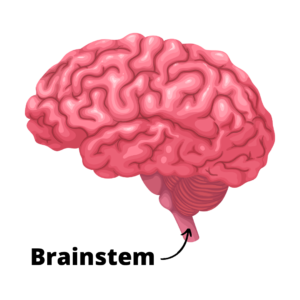In this article
Many who have ongoing headaches and migraines suffer negative effects in their day-to-day lives. The painful symptoms have a significant negative impact on their well-being.
Headaches and Migraines Australia report that headaches are one of the most common symptoms humans can experience. In fact, there are over 200 types of headaches recognised in the International Classification of Headache Disorders (ICHD-3).
Traditionally, headaches have been categorised into numerous conditions such as migraines, cluster headaches, cervicogenic headaches, tension headaches, and menstrual migraines to name a few.
Research by leading Australian Musculoskeletal Physiotherapist, Dean Watson Ph.D., suggests many of these conditions are caused by a sensitised brainstem.
Do you regularly experience headaches? Are you struggling to find the cause or a long-term solution?
Beating headaches and migraines depends on correctly diagnosing and treating the cause.
Here we discuss the brainstem and how it may be contributing to your headaches. We will describe the symptoms of a brain stem headache including aura migraines and we explain how a sensitised brainstem may be treated.


Understanding your brainstem headaches
The brainstem is the stem-like structure connecting the nerves from the brain to the rest of the body via the spinal cord. It connects to the first three vertebrae of the upper cervical spine, also known as the C0-3 region.
The brainstem filters information, such as pain messages, from the body to the brain.
A dysfunction or misalignment of these three vertebrae is often the cause of a sensitised brainstem and can be the true cause of many headaches.
What’s a sensitised brainstem you ask?
Well, if the joints in the top three vertebrae (C0-3 region) are not correctly aligned, they become irritated and in turn, irritate or sensitise the brainstem.
Once the brainstem is sensitised, the amount of information passing through becomes magnified and experienced as an overload. When the brain tries to make sense of the overwhelming amount of information it’s receiving, it finds there is something wrong. In response to this, the brain sends pain signals to warn you.
The result is severe head pain or headache.
What does a sensitised brainstem headache feel like?
Some commonly occurring headache symptoms for those who have a sensitised brainstem include
- Stiff and painful neck
- Difficulty concentrating or brain fog
- Dizziness
- Double vision
- Nausea
In some serious cases, people can experience brainstem aura migraine headaches.
What is a brainstem aura migraine headache?
Migraine and Headaches Australia explain that the term migraine aura refers to a collection of symptoms that may affect your senses before or during a migraine attack. Migraine with brainstem aura specifically refers to symptoms that originate from the brainstem.
As well as any of the common brainstem headache symptoms, migraine with brainstem aura may begin with vertigo, loss of muscle control, and speaking and hearing difficulties.
As the migraine progresses you may experience:
- Extreme headache symptoms
- Numbness in your head, face, and hands
- Visual disturbances including seeing spots, stars, lines, or flashing lights
- Double vision
- Confusion or disorientation
- Decreased consciousness or blacking out
How can we treat a brainstem headache
Often, medication is the first solution we turn to manage the pain. However, medications only provide temporary relief before the headache strikes again. The reason for this is that pain medication only masks the symptoms of your condition, it doesn’t treat the cause of your headaches.
It’s no surprise they continue to reoccur.
If you have been experiencing ongoing headaches and migraines, our spinal consultant, Mr. Leo Hyun is trained in the Watson Headache Approach, a method of assessment and treatment that can determine whether the neck (more specifically the upper cervical spine) is causing your headaches or migraines.
The Watson Headache Approach has been developed over 20 years and has been used on over 8000 migraine and headache patients. Only practitioners who have been specially trained in the technique can deliver the treatment.
The Watson Headache Approach is a method of assessing how your neck moves and treating problems in the brainstem.
The Watson approach involves gently adding pressure to the upper cervical spine to reproduce your headache symptoms. If symptoms appear this indicates your neck is, in fact, the real cause of your condition. From here, gentle manipulation of the upper cervical spine will be performed to desensitise the spinal cord, in real-time, while reversing the symptoms.
To learn more about The Watson Headache Approach and how we use it to provide treatment for headaches and migraines, check out our ‘Watson Headache Approach’ blog post.
If you regularly experience headaches and you’re wondering if your neck may be the cause, give us a call at The Brisbane Spine Clinic. A thorough assessment of your condition by our spinal consultant may make all the difference to your life and well-being.
For more information, or to schedule an assessment of your headache or migraine symptoms, please book an appointment.
References
Headaches and Migraines Australia. (2022). What is Migraine Aura?
Headaches and Migraines Australia. (2022). What is a headache.
https://headacheaustralia.org.au/what-is-headache/
International Headache Society. (2021). The International Classification of Headache Disorders.
Physiopedia. (2022). Brainstem. https://www.physio-pedia.com/Brainstem
Watson Headache Approach. (2022). The Watson Headache Approach.
Watson, D. H., & Drummond, P. D. (2012). Head pain referral during examination of the neck in
migraine and tension-type headache. Headache, 52(8), 1226–1235. https://doi.org/10.1111/j.1526-4610.2012.02169.x
Watson, D. H., & Drummond, P. D. (2014). Cervical referral of head pain in migraineurs: effects on
the nociceptive blink reflex. Headache, 54(6), 1035–1045. https://doi.org/10.1111/head.12336







